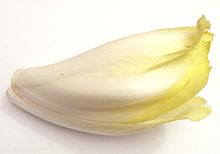
Blanching is a technique used in vegetable growing. Young shoots of a plant are covered to exclude light to prevent photosynthesis and the production of chlorophyll, and thus remain pale in color. Different methods used include covering with soil (hilling or earthing up) or with solid materials such as board or terracotta pots, or growing the crop indoors in darkened conditions. [1] [2] Blanched vegetables generally tend to have a more delicate flavor and texture compared to those that are not blanched, [3] [4] but blanching can also cause the vegetables to be lower in vitamin A. [5]
